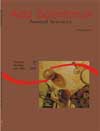<b>Effect of retanning techniques on the resistance of the Nile tilapia leather (<em>Oreochromis niloticus</em> L.)</b> - DOI: 10.4025/actascianimsci.v27i4.1185
Abstract
The aim of this work was to evaluate the resistance of the Nile Tilapia leather (Oreochromis niloticus) tanned with chromium salts and different techniques of retanning. The skin was distributed in randomized blocks, in a 4x2 factorial design, presenting four techniques of retanning, (T1 = 4% of chromium salts; T2 = 4% vegetal tanning barks; T3 = 4% synthetic tanning barks and T4 = 2% synthetic tanning barks and 2% vegetables) and two directions of the leather (S1=Longitudinal; S2=Transversal), with 6 repetitions. In order to determine the resistance to traction, elongation and gradual tearing were used dynamometer EMIC, with offset speed between 100 loads ± 20 mm/mm, in climatized environment (±23ºC and UR of the 50% air), for 24 hours (ABNT-NBR 10455, 1988). The retanning technique influenced the thickness of the leather which became inferior (1.30 to 1.53 mm) to other treatments due to the chromium salts (T1=0.61 to 0.68 mm). The course of the leather did not influence the thickness. The leather retanned with chromium salts did not present significant values for traction (30.31 N/mm2), elongation (52.42%) and gradual tearing (91.23 N/mm) compared with the tanned ones with vegetal, synthetic tanning barks or combined values. The longitudinal section of the leather presented superior traction (23.00 N/mm2) compared with the transversal line (12.3 N/mm2); however it did not differ in the test from elongation and gradual tearing between the longitudinal and the transversal one. According to standards in literature, the leather tanned in chromium should present a resistance to traction of about 9.80 N/mm2, 60% for elongation and 14.0 N/mm for rip. The skin tanned with chromium and retanned with chromium salts presented the more adequate values to the recommended one for clothes confectionDownloads
Download data is not yet available.
Published
2008-03-14
How to Cite
Souza, M. L. R. de, & Oliveira da Silva, L. (2008). <b>Effect of retanning techniques on the resistance of the Nile tilapia leather (<em>Oreochromis niloticus</em> L.)</b> - DOI: 10.4025/actascianimsci.v27i4.1185. Acta Scientiarum. Animal Sciences, 27(4), 535-540. https://doi.org/10.4025/actascianimsci.v27i4.1185
Issue
Section
Animal Production
DECLARATION OF ORIGINALITY AND COPYRIGHTS
- I Declare that current article is original and has not been submitted for publication, in part or in whole, to any other national or international journal.
The copyrights belong exclusively to the authors. Published content is licensed under Creative Commons Attribution 4.0 (CC BY 4.0) guidelines, which allows sharing (copy and distribution of the material in any medium or format) and adaptation (remix, transform, and build upon the material) for any purpose, even commercially, under the terms of attribution.
Read this link for further information on how to use CC BY 4.0 properly.
0.9
2019CiteScore
29th percentile
Powered by 








































